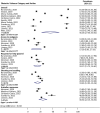Prevalence of obstetric violence in high-income countries: A systematic review of mixed studies and meta-analysis of quantitative studies
- PMID: 39278647
- PMCID: PMC11683541
- DOI: 10.1111/aogs.14962
Prevalence of obstetric violence in high-income countries: A systematic review of mixed studies and meta-analysis of quantitative studies
Abstract
Introduction: Obstetric violence, or mistreatment of women in obstetric care, can have severe consequences such as fear of future childbirth, post-traumatic stress disorder, and depression.
Material and methods: The primary objective was to estimate the prevalence of obstetric violence in high-income countries. The secondary objective was to extract the main domains of obstetric violence perceived by women from qualitative studies. Following prospective registration (PROSPERO CRD42023468570), PubMed, Web of Science, Scopus, CINAHL, Embase, and Cochrane Library were searched with no restrictions. Included studies were cross-sectional, cohort, mixed methods, and qualitative studies based on populations from high-income countries. The review was conducted by two independent reviewers. Risk of bias was assessed. Rates of obstetric violence were pooled using random effects model, computing 95% confidence intervals (CI) and assessing heterogeneity using I2 statistic. Funnel plots and Egger's test were used to detect potential reporting biases and small-study effects.
Results: Of the 1821 records screened, 25 studies were included: 14 quantitative and 2 mixed methods studies, comprising 60 987 women, and 9 qualitative studies were included, comprising an additional 4356 women. 81.25% of quantitative studies, including the quantitative component of the mixed methods studies, were considered satisfactory or better regarding risk of bias. The prevalence of obstetric violence was overall 45.3% (95% CI 27.5-63.0; I2 = 100.0%). The prevalence of specific forms of mistreatment was also estimated. Lack of access to analgesia was 17.3% (95% CI 6.9-27.7; I2 = 99.7%). Ignored requests for help was 19.2% (95% CI 11.7-26.6; I2 = 99.0%). Shouting and scolding 19.7% (95% CI 13.0-26.4; I2 = 98.7%). The use of fundal pressure during the second stage of labor (Kristeller maneuver) was 30.3% (95% CI 22.1-38.5; I2 = 97.6%). There was no funnel asymmetry. Lack of information and/or consent were the most frequent domains extracted from the qualitative articles and the qualitative component of the mixed methods studies.
Conclusions: The results demonstrate that obstetric violence is a prevalent problem that women in high-income countries experience. Lack of information and/or consent were the domains most frequently described in the qualitative studies and the qualitative component of the mixed methods studies.
Keywords: disrespect and abuse in obstetric care; obstetric violence; women's rights.
© 2024 The Author(s). Acta Obstetricia et Gynecologica Scandinavica published by John Wiley & Sons Ltd on behalf of Nordic Federation of Societies of Obstetrics and Gynecology (NFOG).
Conflict of interest statement
The authors declare no conflicts of interest.
Figures
References
-
- Organisation WH . The prevention and elimination of disrespect and abuse during facility‐based childbirth . 2014:4. https://iris.who.int/bitstream/handle/10665/134588/WHO_RHR_14.23_eng.pdf
-
- Martínez‐Galiano JM, Martinez‐Vazquez S, Rodríguez‐Almagro J, Hernández‐Martinez A. The magnitude of the problem of obstetric violence and its associated factors: a cross‐sectional study. Women Birth. 2021;34:e526‐e536. - PubMed
Publication types
MeSH terms
LinkOut - more resources
Full Text Sources



